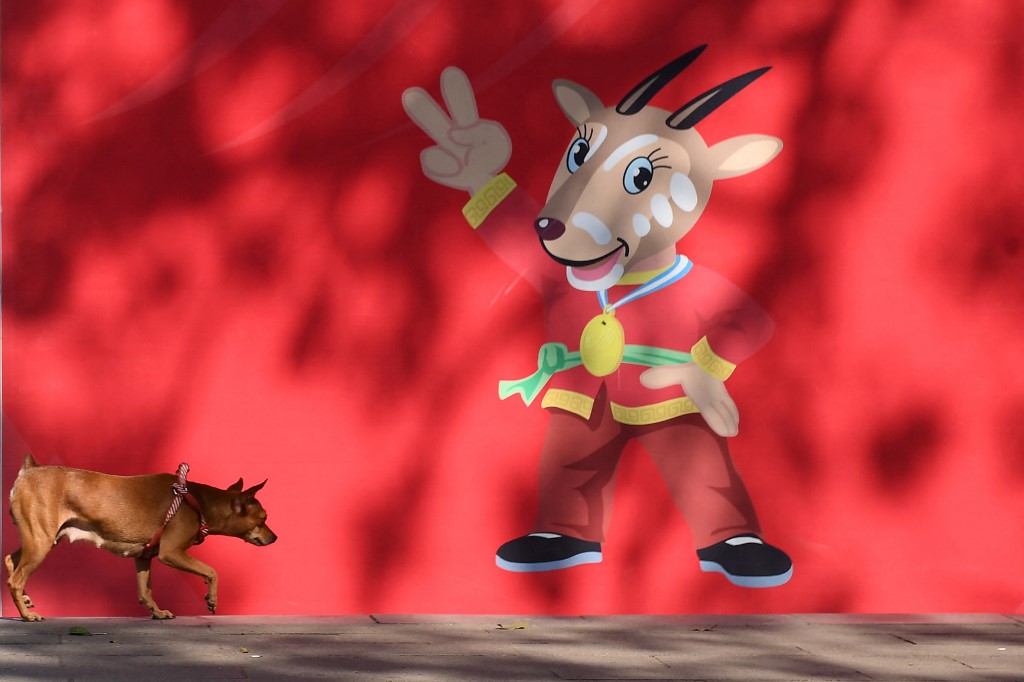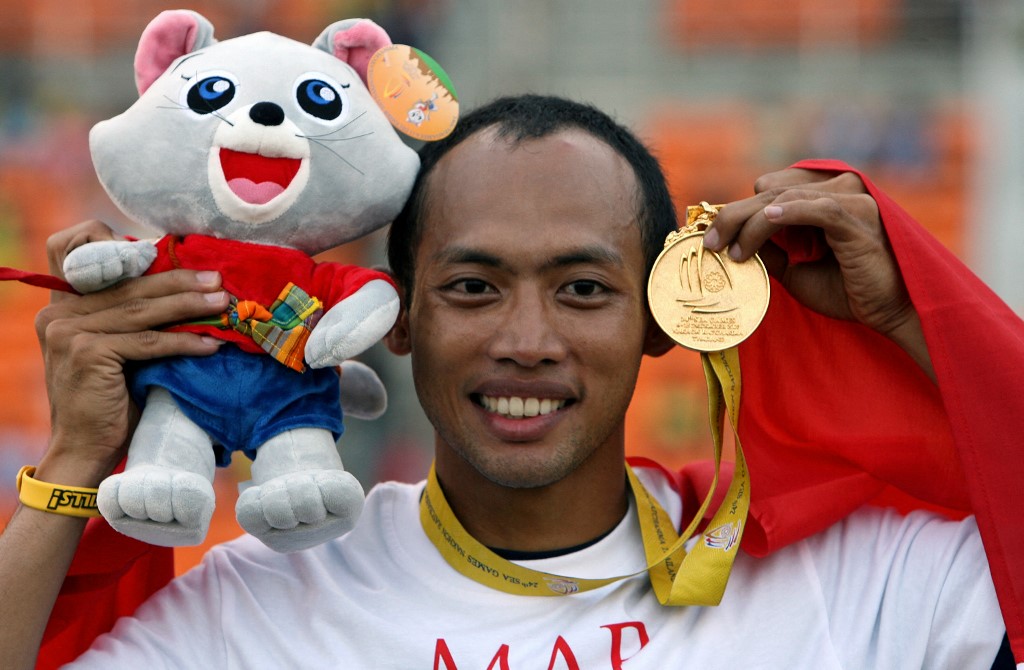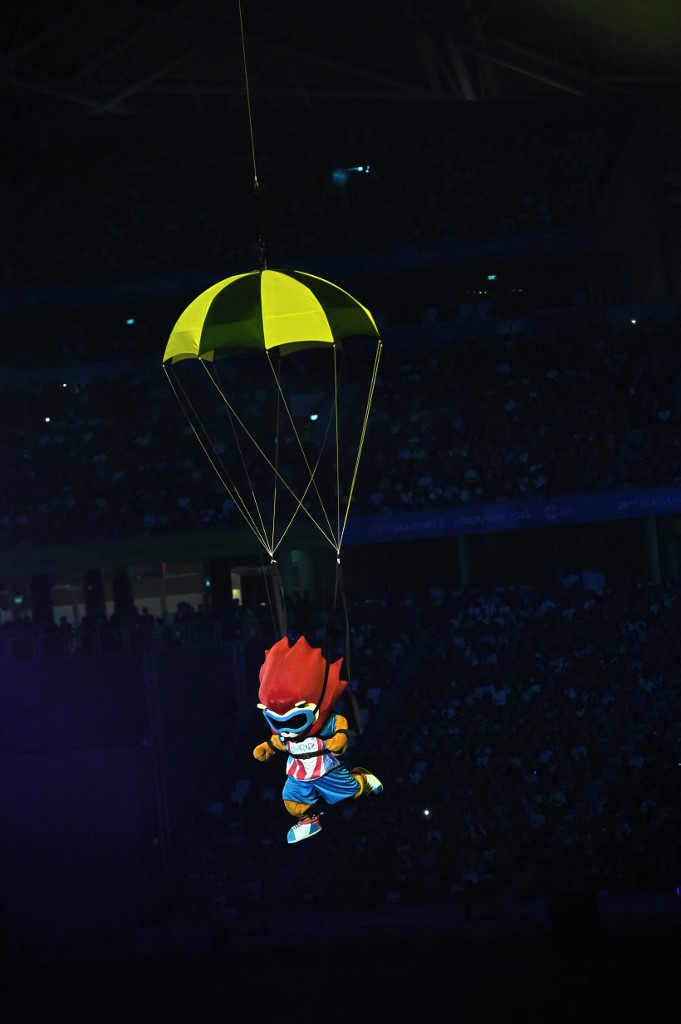Explainer: SEA Games and their various mascots
The 2021 Southeast Asian Games, hosted by Vietnam, has Sao La as the mascot. It was inspired by the Vu Quang bovid, a rare, forest-dwelling bovine, which was found in 1992 in the Annamite Range in Vietnam. The mascot was chosen after a two-year contest that drew some 500 entries.
According to the definition, a mascot is a symbol used to represent an idea. It also serves as a message at sports competitions. At most SEA Games, a quadrennial event, the hosts combine animals with human-like characters. Their expressions are bright and cheerful with a child-like, adorable quality, while symbolizing the identity of the host country.

A dog walks in front of a banner with the image of the official mascot for the upcoming 31st Southeast Asian Games (SEA Games) in Hanoi on May 4, 2022, before the start of the multi-sport event on May 12. (Photo by Nhac NGUYEN / AFP)
“Sao La”, the animal that was found first in Vietnam, the host of the 31st Southeast Asian Games, has combined the images of a dove and a human hand to create a “V” shape for the logo, representing Peace, Vietnam, and Victory.
The mascot was named “Sao La” or “Vu Quang bovid,” representing the biodiversity in the Annamite Range which lies on the Vietnam-Laos border. Saola was also reported to be found only in the Annamite Range.
Saola is one of the world’s rarest large mammals. It has an appearance of a goat combined with serows. It is classified under the Bovidae family, the same as cows. It has two horns, so many people in Laos call this animal “Sao-La,” which has a similar pronunciation.
There is no evidence available on the origins of the name. In the Vietnamese language, it means rarity and beauty.
Cat and elephant – symbols of Thailand

Indonesia’s Suryo Agung Wibowo poses with his gold medal and mascot after winning the men’s 100m of the 24th Southeast Asian Games (SEA games) in Korat, 07 December 2007. AFP PHOTO/ Saeed KHAN
Cats and elephants have been used symbolically by Thailand for a long time. In the 1998 Asian Games in Thailand, an elephant named Chai-Yo was the mascot while the motto was “Friendship beyond Frontiers.”
At the last two Southeast Asian Games hosted by Thailand — in 1995 and 2007 — cats served as mascots.
The 1995 Southeast Asian Games were held in Chiang Mai and the 700th Anniversary Stadium was used as the main venue.
The mascot for the Games was a Siamese cat named Sawasdee. It is believed that Siamese cats bring luck and they were kept in the palace since the Ayutthaya Kingdom.
The red umbrella carried by the cat was representative of Chiang Mai’s Bo Sang Village, which is famous for its exquisite hand-made and painted umbrellas. The name ‘Sawasdee’ represented Thainess and the identity of Chiang Mai.
The 2007 SEA Games hosted by Thailand were held in Nakhon Ratchasima province. The mascot for this competition was a Korat cat named Can. It has its origin in the Phimai district of Nakhon Ratchasima. The mascot, clad in a “Pha Khao Ma,” a traditional Thai loincloth, and playing the khaen, a Northeastern-style mouth organ, represented Thainess and the Northeastern region.
Lion and tiger

SEA Games mascot “Nila” is seen at the opening ceremony of the biennial Southeast Asian (SEA) Games in Singapore’s National Stadium on June 5, 2015 AFP PHOTO / ROSLAN RAHMAN
Singapore chose a lion named Nila as the mascot for the 2015 SEA Games. The lion is the national animal of Singapore while the name Nila came from Singapore’s founder Sang Nila Utama. Nila had a red mane and heart-shaped face and was described as courageous, passionate and friendly.
In the 2017 SEA Games, hosts Malaysia chose the Malayan tiger as a mascot. It was named Rimau, an abbreviation of the games’ core values: Respect, Integrity, Move, Attitude and Unity.
The Malayan tiger could symbolize the country as Malaysia is located in the middle and the lower part of the Malay Peninsula. The tiger is highly regarded in Malaysia as it is present in Malaysia’s coat of arms, symbolizing strength and courage.
Therefore, the tiger is the symbol for Malaysia in sports as we have seen the yellow tiger symbol often.
‘Pami’ a symbol for unity
A mascot does not have to always come from animals. The 2019 SEA Games host, the Philippines, did not use an animal as a mascot but a simple design, “Pami”, was chosen to represent the family.
Pami comprised four circles with four different colors from the flag of the Philippines — white, blue, red, and yellow. The motto of the competition was “We Win as One.”
These are examples of mascots used in the SEA Games. They are not only charming and attractive but they also can unite and reduce tensions in the competition because the SEA Games is held to forge deeper ties among Southeast Asian countries.